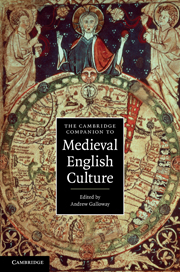Book contents
- Frontmatter
- Introduction
- Part one Theaters of culture: political, legal, material
- Part two Cultural ideals and cultural conflicts
- 4 Social ideals and social disruption
- 5 “Celtic” Visions Of England
- 6 The idea of sanctity and the uncanonized life of Margery Kempe
- Part Three Literacies, languages, and literatures
- Part four Legacies and re-creations
- Guides to further reading
- Index
5 - “Celtic” Visions Of England
from Part two - Cultural ideals and cultural conflicts
Published online by Cambridge University Press: 28 July 2011
- Frontmatter
- Introduction
- Part one Theaters of culture: political, legal, material
- Part two Cultural ideals and cultural conflicts
- 4 Social ideals and social disruption
- 5 “Celtic” Visions Of England
- 6 The idea of sanctity and the uncanonized life of Margery Kempe
- Part Three Literacies, languages, and literatures
- Part four Legacies and re-creations
- Guides to further reading
- Index
Summary
Defining “the Celts”
There was no medieval idea of contemporary celticity in the second half of the Middle Ages. Insofar as the word “Celts” might be used, it was in reference to Antiquity, prompted by Classical Latin authors. We must therefore understand that in proceeding under this banner we are imposing our sense of a linguistically defined overarching identity (deriving essentially from the work of Edward Lhuyd [Llwyd], d. 1709) on the cultural politics of an era innocent of that. Britons (Bretons, Cornish, and Welsh) and Gaels (of Irish, Manx, and Scottish sorts) were each aware of a common share of identity defined by heritage; Gaels shared mutually comprehensible language and social mores. But none could or did celebrate their celticity.
Englishness was a more immediate and tangible identity because the kingdom of the English had constituted a political focus since 927, and the Norman Conquest did not call that kingdom into question. Celticity and Englishness are false partners: die Kelten and die Germanen (the terms of nineteenth-century German scholars seeking the earliest cultures and “races” of Europe) are commensurate, but not useful in the present context. Bretons and Cornish and Irish and Welsh are such comparanda for the English at the beginning of our period, but many Bretons had received French culture and, although the Cornish language and culture endured, Cornwall was nonetheless but a county of England with no realistic hope of escape from the embrace of conquerors whether English or French in culture.
- Type
- Chapter
- Information
- The Cambridge Companion to Medieval English Culture , pp. 107 - 128Publisher: Cambridge University PressPrint publication year: 2011
- 1
- Cited by



